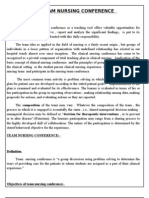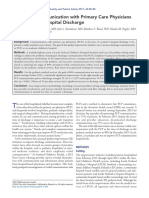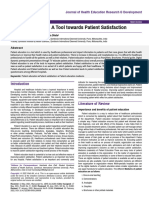Presentation Poster
Presentation Poster
Uploaded by
api-663253917Copyright:
Available Formats
Presentation Poster
Presentation Poster
Uploaded by
api-663253917Original Title
Copyright
Available Formats
Share this document
Did you find this document useful?
Is this content inappropriate?
Copyright:
Available Formats
Presentation Poster
Presentation Poster
Uploaded by
api-663253917Copyright:
Available Formats
Using Medication Flashcards to Help Improve HCAHPS Scores
Darian Williams, Grace Topham, Macy Martin, Riley Hantin, Trevor Curran
Bon Secours Memorial College of Nursing
Abstract
Purpose: To find a way to give information in a Data and Analysis of the Issue AIMProposed
- Proposed Solution
Solution Conclusion
comprehensive way by using medical flashcards.
Based on interviews with nurse manager, and review of
These tools can be used to help implement We aim to increase medication education • Issue: There is a lack of reinforcement for
patients, review of 13 survey responses by patients and 6
improve patient satisfaction in their responses by nurses: HCAPHS scores related to medication side medication side effect education as shown by
medical education and decrease information • Nurses spend an average of 10-15 minutes in each room effects from 50% to 60% by December 2023. the reported HCAHPS score of 50%.
overload. on medication education. Hypothesis:
Background: The HCAHPS, Hospital Consumer • 100% of nurses cited using the teach back method or If we use visual aids with teaching, • Data analysis: We collected our data through
Assessment of Healthcare Providers and Systems, is verbalized understanding. then the HCAHPS score for "how often staff and patient interviews, surveys, and
a national standardized, publicly reported survey • The unit has a medication cheat sheet that is reportedly did the nurse educate you on possible side observation of patient medication education.
underutilized. effects in a way you can comprehend”
and data collection methodology for measuring
• Patient responses on time spent on medication
patients’ perceptions of their hospital experience. will increase. • Root Cause: The identified root cause of a
education varied. Most answered frequently or always
It has several key topics, one of (8); 4 responded sometimes or rarely. Proposed Solution: HCAHPS score of 50% at SFMC is lack of
which communication about patients’ medications • Patients are not surveyed on learning style during We propose the use of a medication flashcard medication information reinforcement.
is the focus of this project. (U.S. Centers for admission process. index to promote reinforcement of education
Medicare and Medicaid Services, 2021) • Majority of nurses and nurses stated they would use material. We believe increased access to • Proposed Solution: Medication education will
Proposed Solution: Individual medication individualized medication visual aids. material will improve retention and therefore be provided by a flashcard index that will
flashcards are to be made with simplified Summary of Supporting Litrature: increase HCAPHS scores. contain visual aids for reinforcement.
• Just over half of the nurses interviewed believe that it's
information of commonly administered
medications for both the rooms and patients, post-
important to provide education on refill or old
medications (Bowen et al., 2017)
Stake Holders
discharge. • Most spent an average of 5-9 minutes on medication Logistics
Implication for Practice: Improvement of education per patient (Bowen et al., 2017) • Obtaining list of common medications administered.
References
educational materials and reinforcement can lead • As for time spent on tasks, nurses spend most of their • Printing and creating medication flashcards for rooms and patients for
discharge
Agency for Healthcare Research and Quality. (2020,
to better perception of the hospital, improved time charting on patients in EHR (Yen et al., 2018) September). Use the teach-back method: Tool #5. AHRQ. Retrieved
• Nurses' confidence in patient's ability to March 2, 2023, from https://www.ahrq.gov/health-
HCAPHS scores, and lower readmission rates. This literacy/improve/precautions/tool5.html
increases the hospital standing among competitors identify medication and potential side effects
after education: Stakeholders
and lowers overall costs. Bowen, J. F., Rotz, M. E., Patterson, B. J., & Sen, S. (2017). Nurses'
Introduction and Description of •
•
Clinical care lead
Nurses
attitudes and behaviors on patient medication
education. Pharmacy practice, 15(2),
the Issue •
•
Patients
Pharmacists
930. https://doi.org/10.18549/PharmPract.2017.02.930
Macro Description: Hume, K., & Tomsik, E. (2014). Enhancing patient education and
• HCAHPS is a tool used medication reconciliation strategies to reduce readmission
to survey patients' perspectives of hospital care. Potential costs rates. Hospital pharmacy, 49(2), 112–
• Relatively cheap to produce. 114https://doi.org/10.1310/hpj4902-112
This survey includes instrument and data • 4x6 card stock $7.99 per 500 cards
collection tool • Lamination sheets $19.89 per 100 pouches. U.S. Centers for Medicare and Medicaid Services. (2021, December
• 2" book rings- $11.59 per 50
for measuring patients' perceptions of • Laminator $33.49 (if none is available)
1). HCAHPS: Patients' perspectives of care survey. CMS. Retrieved
their hospital experience ( CMS, 2021) • Total Cost: 7 cents per card plus 23 cents per ringlet. (23¢ + 7(n) ¢) March 7, 2023, from https://www.cms.gov/Medicare/Quality-
Initiatives-Patient-Assessment-
• The Teach-back method displays that a patient is Instruments/HospitalQualityInits/HospitalHCAHPS
Timeline
receiving information in a way they understand,
• Proposal of idea: 4/4/23
regardless of health literacy (AHRQ,2020). • Proposal brought before Administration: 5/23
Yen, P. H., & Leasure, A. R. (2019). Use and Effectiveness of the
• Medication education is important for patient • Approval of project: 6/23
Teach-Back Method in Patient Education and Health Outcomes.
safety and helps reduce readmission rates (Hume • Survey of most common medications completed: 7/23
• Creation of medication flashcard index: 8/23
Federal practitioner : for the health care professionals of the VA,
& Tomsik, 2014). Root Cause • Implementation on unit: 9/23 DoD, and PHS, 36(6), 284–289.
Micro Description: The Medical Surgical unit of
Based on our analysis of collected data and literature Yen, P. Y., Kellye, M., Lopetegui, M., Saha, A., Loversidge, J., Chipps,
SFMC reported an HCAHPS score of 50% related Data Collection E. M., Gallagher-Ford, L., & Buck, J. (2018). Nurses' Time Allocation
to “how often did the nurse educate you on review, we believe the root cause is a lack of • Patient survey through leader rounds and Multitasking of Nursing Activities: A Time Motion Study. AMIA
possible side effects in a way you can comprehend." reinforcement of medication information during the • Quarterly HCAPHS survey scores ... Annual Symposium proceedings. AMIA Symposium, 2018, 1137–
hospital stay. 1146.
You might also like
- NURS-FPX 4020 - MuaClaude - Assessment 3 - 1Document11 pagesNURS-FPX 4020 - MuaClaude - Assessment 3 - 1marvinNo ratings yet
- Evidence Based PracticeDocument14 pagesEvidence Based PracticeKrini Tandel100% (2)
- Primary Health Care: Mr. John Michael M. Pitoy, B.S.N., R.NDocument44 pagesPrimary Health Care: Mr. John Michael M. Pitoy, B.S.N., R.NJohn Michael Manlupig Pitoy100% (9)
- NURS - FPX 5005 - Brendan Madden - Assessment - 2-1Document9 pagesNURS - FPX 5005 - Brendan Madden - Assessment - 2-1SohaibNo ratings yet
- Table-5 - SAE Form - 7dec22Document5 pagesTable-5 - SAE Form - 7dec22Avinash AviNo ratings yet
- PNDSDocument9 pagesPNDSivy_espesoNo ratings yet
- Team Nursing ConferenceDocument9 pagesTeam Nursing ConferenceShesly Philomina100% (5)
- Evidence Based PracticeDocument18 pagesEvidence Based Practicemeghana100% (11)
- Classical Pearls - Natur Terapi - Behandla - GuDocument89 pagesClassical Pearls - Natur Terapi - Behandla - Gufriend717No ratings yet
- CKD Case StudyDocument16 pagesCKD Case StudyLynne Cisquette100% (1)
- Career OpportunitiesDocument38 pagesCareer Opportunitiesrajinikarthicks77% (13)
- Retrieve 1Document6 pagesRetrieve 1mariacoevordenNo ratings yet
- Poster Template 20191206Document1 pagePoster Template 20191206api-402053549No ratings yet
- Ebp Perspectives PaperDocument7 pagesEbp Perspectives Paperapi-706947027No ratings yet
- Faculty Development One MinuteDocument9 pagesFaculty Development One MinuteDaniel Alejandro Lozano MorenoNo ratings yet
- Poster Template 20191206Document1 pagePoster Template 20191206api-402050848No ratings yet
- The Middle East Under RomeDocument1 pageThe Middle East Under Romeglovermichael96024No ratings yet
- Adolescent Depression Course: Ashley Barber, DNP, CPNP-PC, PmhsDocument11 pagesAdolescent Depression Course: Ashley Barber, DNP, CPNP-PC, Pmhsapi-726150955No ratings yet
- Ebp 2-2Document5 pagesEbp 2-2api-302054478No ratings yet
- Using Field Notes To Evaluate Competencies in Family Medicine Training: A Study of Predictors of IntentionDocument10 pagesUsing Field Notes To Evaluate Competencies in Family Medicine Training: A Study of Predictors of IntentionMirna Liliana Carmona GarciaNo ratings yet
- Chapter 5 MAA PresentationDocument21 pagesChapter 5 MAA PresentationAaron WallaceNo ratings yet
- Teaching The Medical Interview: Methods and Key Learning Issues in A Faculty Development CourseDocument8 pagesTeaching The Medical Interview: Methods and Key Learning Issues in A Faculty Development CourseMaw BerryNo ratings yet
- Ebp in Addis Ababa Mixed MethodDocument11 pagesEbp in Addis Ababa Mixed MethoddemwodewNo ratings yet
- Key Points: Success in Changing Behaviors or Learning How To Self Monitor ADocument2 pagesKey Points: Success in Changing Behaviors or Learning How To Self Monitor AKurnia Putra WardhanaNo ratings yet
- 01 NL Trong Tam Va 6 NL Cot Loi - Sinh VienDocument130 pages01 NL Trong Tam Va 6 NL Cot Loi - Sinh VienTrang BùiNo ratings yet
- Ebnp by DR Nandini MDocument75 pagesEbnp by DR Nandini MnandiniNo ratings yet
- A Method of Teaching Clinical Problem Solving Skills To Primary Health Care Student NursesDocument5 pagesA Method of Teaching Clinical Problem Solving Skills To Primary Health Care Student NursesJugal HarkutNo ratings yet
- Medication Discharge Planning Prior To Hospital DischargeDocument11 pagesMedication Discharge Planning Prior To Hospital DischargeAdil Akaaboune100% (1)
- Nurs402 Teachingprojectsummary NeuburgDocument20 pagesNurs402 Teachingprojectsummary Neuburgapi-452041818No ratings yet
- Evidence-Based Nursing: The 5 Steps of EBNDocument13 pagesEvidence-Based Nursing: The 5 Steps of EBNRanjith RgtNo ratings yet
- Improving Communication With Primary Care Physicians at The Time of Hospital DischargeDocument9 pagesImproving Communication With Primary Care Physicians at The Time of Hospital DischargeEmily MoriartyNo ratings yet
- NCM 119 LM EndtermDocument10 pagesNCM 119 LM EndtermJmarie Brillantes PopiocoNo ratings yet
- Annotated BibDocument4 pagesAnnotated BibAmelia ArnisNo ratings yet
- Critically Appraised Articles 3Document15 pagesCritically Appraised Articles 3api-638750949No ratings yet
- ANP - EBP Model ASHDocument12 pagesANP - EBP Model ASHManoj Bala100% (1)
- Tracie A Caller Design and Feasibility of A MemoryDocument3 pagesTracie A Caller Design and Feasibility of A Memoryalison.belenoNo ratings yet
- Qi ProjectDocument1 pageQi Projectapi-663860143No ratings yet
- Fisher 2017Document6 pagesFisher 2017Bogdan NeamtuNo ratings yet
- Evidence Based Practice A Concept AnalysisDocument7 pagesEvidence Based Practice A Concept Analysissana naazNo ratings yet
- For ResearchDocument23 pagesFor ResearchJimlord GarciaNo ratings yet
- MBE en El Currículo Médico Actual GuyattDocument3 pagesMBE en El Currículo Médico Actual GuyattmedicabrujaNo ratings yet
- Critique Qualitative Nursing Research PaperDocument7 pagesCritique Qualitative Nursing Research Papermwjhkmrif100% (1)
- H C P T I O: Ealth ARE Rovider in Riage To Mprove UtcomesDocument6 pagesH C P T I O: Ealth ARE Rovider in Riage To Mprove Utcomesbayu sih aksami khasanahNo ratings yet
- Pediatric Nurses Perception of Workload in A Large System InfusiDocument78 pagesPediatric Nurses Perception of Workload in A Large System InfusiAhmad A'shuaibiNo ratings yet
- Chapter 24 Translating Research Into PracticeDocument8 pagesChapter 24 Translating Research Into PracticeLorene ReynoldsNo ratings yet
- Evidence Based Practices: CORE ConceptsDocument154 pagesEvidence Based Practices: CORE ConceptsJasthen Audrey StamboughNo ratings yet
- E BM White PaperDocument14 pagesE BM White PaperpongidaeNo ratings yet
- 2014 Eberhart DNP Final Project PDFDocument81 pages2014 Eberhart DNP Final Project PDFaya PermatasariNo ratings yet
- Applying Nursing Process Education in Workshop FrameworkDocument6 pagesApplying Nursing Process Education in Workshop FrameworkGuru DevNo ratings yet
- PublishedEBParticle JournalofAlliedHealth CardinDocument11 pagesPublishedEBParticle JournalofAlliedHealth Cardinag wahyudiNo ratings yet
- Assignment of AnpDocument18 pagesAssignment of Anpcharanjit kaurNo ratings yet
- Summary, Conclusions and RecommendationsDocument8 pagesSummary, Conclusions and RecommendationssshhaplNo ratings yet
- Nu708 m7 - Ebp Perspective SustainabilityDocument8 pagesNu708 m7 - Ebp Perspective Sustainabilityapi-577441503No ratings yet
- 10 1016@j Accpm 2019 10 019Document6 pages10 1016@j Accpm 2019 10 019Sri NingsihNo ratings yet
- Clinical Nursing JudgmentDocument6 pagesClinical Nursing Judgmentapi-739523749No ratings yet
- Evidence Based NursingDocument7 pagesEvidence Based NursingCzaesarJohnbertUrbiztondoNo ratings yet
- Final Facilitator Guide Submission (B)Document38 pagesFinal Facilitator Guide Submission (B)seife slassieNo ratings yet
- Translate AnakDocument12 pagesTranslate AnakAndikNo ratings yet
- Patient Education a Tool Towards Patient SatisfactionDocument4 pagesPatient Education a Tool Towards Patient Satisfactiondr.spicy1981No ratings yet
- 5 HaniberniaDocument6 pages5 HaniberniaAnitha NoronhaNo ratings yet
- Topic-Evidence Based Nursing Practice And: Best PracticesDocument15 pagesTopic-Evidence Based Nursing Practice And: Best PracticesgemergencycareNo ratings yet
- Evidence Based Nursing Practice - A ReviewDocument4 pagesEvidence Based Nursing Practice - A ReviewEditor_IAIM100% (1)
- Interprofessional Edited EditedDocument4 pagesInterprofessional Edited EditedjuliuswamuguNo ratings yet
- Relationship Between Health Literacy Scores and Patient Use of the iPET for Patient EducationFrom EverandRelationship Between Health Literacy Scores and Patient Use of the iPET for Patient EducationNo ratings yet
- 1200 NCLEX-RN Exam Practice Questions and Answers: Includes 4 Full-Length Practice Test Exams for Exam SuccessFrom Everand1200 NCLEX-RN Exam Practice Questions and Answers: Includes 4 Full-Length Practice Test Exams for Exam SuccessNo ratings yet
- Final AnalysisDocument3 pagesFinal Analysisapi-663253917No ratings yet
- Health Promotion ProjectDocument14 pagesHealth Promotion Projectapi-663253917No ratings yet
- Advocacy PaperDocument2 pagesAdvocacy Paperapi-663253917No ratings yet
- Trevor Curran ResumeDocument2 pagesTrevor Curran Resumeapi-663253917No ratings yet
- 2020 Nursing ChecklistDocument6 pages2020 Nursing Checklistapi-663253917No ratings yet
- Personal Philosophy and Reflection On NursingDocument8 pagesPersonal Philosophy and Reflection On Nursingapi-663253917No ratings yet
- Final Integrative Review of The LiteratureDocument17 pagesFinal Integrative Review of The Literatureapi-663253917No ratings yet
- Latest Trends DRDocument5 pagesLatest Trends DRAmadea WPNo ratings yet
- NCP Impaired SkinDocument2 pagesNCP Impaired Skinarjay2306_obcq100% (1)
- Fitness Form & Hospital ListDocument15 pagesFitness Form & Hospital Listjohn thomasNo ratings yet
- Documentation 2Document6 pagesDocumentation 2Eben Alameda-PalapuzNo ratings yet
- HiperleukositosisDocument31 pagesHiperleukositosisNurul Hasanah SururyNo ratings yet
- PDF ESIDocument203 pagesPDF ESIjoko35No ratings yet
- GTR RevisitedDocument3 pagesGTR Revisitedjatt_mu_phattNo ratings yet
- Postoperative Care - KIBI2021Document31 pagesPostoperative Care - KIBI2021Disa AlmiraNo ratings yet
- 10 Golden Rules of IV TherapyDocument8 pages10 Golden Rules of IV Therapybbasya eihynaNo ratings yet
- Trisha MatillanoDocument6 pagesTrisha MatillanoJeyser T. GamutiaNo ratings yet
- The Demographic/ Epidemiologic/ Urban and Nutrition TransitionsDocument69 pagesThe Demographic/ Epidemiologic/ Urban and Nutrition TransitionsMoreiyamNo ratings yet
- Who Should Be Registered: Registration of Patients in Hospital - Policy and ProcedureDocument3 pagesWho Should Be Registered: Registration of Patients in Hospital - Policy and ProceduretanishaNo ratings yet
- What Are Mood DisordersDocument3 pagesWhat Are Mood DisordersKaranpreet ChawlaNo ratings yet
- Uphs GuideDocument2 pagesUphs GuideCristan Dave ZablanNo ratings yet
- Vpe 321Document2 pagesVpe 321ransingh100% (1)
- Medicine: Congenital Chloride Losing DiarrheaDocument9 pagesMedicine: Congenital Chloride Losing DiarrheaGabriela PopescuNo ratings yet
- SUMMATIVE TEST Caregiving 7 Part 3Document1 pageSUMMATIVE TEST Caregiving 7 Part 3Joyce Ann NavalNo ratings yet
- 11-1. OsteoartritisDocument31 pages11-1. OsteoartritisZilhulaifaNo ratings yet
- Understanding Chemotherapy Booklet August 2016Document68 pagesUnderstanding Chemotherapy Booklet August 2016imam trisutrisnoNo ratings yet
- Shankar 2021Document9 pagesShankar 2021fsdfNo ratings yet
- NCISM - II BAMS - AyUG-RNDocument107 pagesNCISM - II BAMS - AyUG-RN43Samprita TripathiNo ratings yet
- Gip District OfficeDocument19 pagesGip District OfficeElmar Jeremy IngenNo ratings yet
- Inglés Ii: Mgtr. Joseph Herbert Común VenturaDocument8 pagesInglés Ii: Mgtr. Joseph Herbert Común VenturaJerson ParionaNo ratings yet
- MoHFW Directory - 7Document17 pagesMoHFW Directory - 7zahabkhan8000No ratings yet
- A Lean Six Sigma Team Increases Hand Hygiene ComplianceDocument10 pagesA Lean Six Sigma Team Increases Hand Hygiene Compliancedrustagi100% (1)
































































































